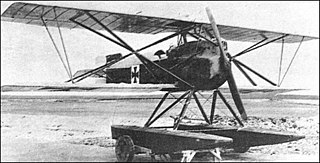
Friedrichshafen FF.33 was a German single-engined reconnaissance three-bay wing structure biplane, using twin floats, designed by Flugzeugbau Friedrichshafen in 1914 for the Marine-Fliegerabteilung aviation forces of the Kaiserliche Marine.

The Rumpler 6B was a German single-engine floatplane fighter with a biplane wing structure, designed and built by Rumpler Flugzeugwerke, in Berlin Johannisthal and introduced in 1916.

The Hansa-Brandenburg KDW was a German single-engine, single-seat, fighter floatplane of World War I. The KDW – Kampf Doppeldecker, Wasser – was adapted from the Hansa-Brandenburg D.I landplane to provide coastal defence over the North Sea.

The Hansa-Brandenburg W.12 was a German biplane fighter floatplane of World War I. It was a development of Ernst Heinkel's previous KDW, adding a rear cockpit for an observer/gunner, and had an unusual inverted tailfin/rudder in order to give an uninterrupted field of fire.

The Hansa-Brandenburg W.29 was a German two-seat fighter floatplane which served in the closing months of World War I with the Imperial German Navy's Naval Air Service from bases on the North Sea coast. In concept the aircraft was a monoplane version of the biplane Hansa-Brandenburg W.12, although there were many structural differences between the two.

The Junkers W 33 was a German 1920s single-engine low-wing monoplane transport aircraft that followed Junkers standard practice making extensive use of corrugated aluminium alloy over an aluminium alloy tube frame, that was developed from the similar but slightly smaller Junkers F 13, and evolved into the similar W 34. One example, named Bremen was the first aircraft to complete the much more difficult east–west non-stop heavier-than-air crossing of the Atlantic.

The Hansa-Brandenburg C.I, also known as Type LDD, was a 2-seater armed single-engine reconnaissance biplane designed by Ernst Heinkel, who worked at that time for the parent company in Germany. The C.I had similarities with the earlier B.I, including inward-sloping interplane bracing struts. Like other early-war Austro-Hungarian reconnaissance aircraft, such as C-types of Lloyd or Lohner, the Type LDD had a communal cockpit for its crew.

The Hansa-Brandenburg W.19 was a German fighter-reconnaissance aircraft of World War I. It was a single-engined two-seat biplane floatplane, and was a larger development of the successful W.12. It served with the Kaiserliche Marine during 1918.

The Hansa-Brandenburg CC was a single-seat German fighter flying boat of World War I. It was used by both the Kaiserliche Marine and the Austro-Hungarian Navy.

The Lohner L was a reconnaissance flying boat produced in Austria-Hungary during World War I. It was a two-bay biplane of typical configuration for the flying boats of the day, with its pusher engine mounted on struts in the interplane gap. The pilot and observer sat side by side in an open cockpit, and both the upper and lower sets of wings featured sweepback.

The Hansa-Brandenburg W.11 was a fighter floatplane built in Germany in 1917 as a more powerful version of the KDW. Similar in general configuration to its predecessor, the W.11 shared the same unusual interplane strut arrangement, and featured fins above and below the fuselage. Only three examples were built.

The Hansa Brandenburg W.27 and W.32 were prototype fighter floatplanes developed in parallel in Germany during World War I. They were developments of and intended replacements for the W.12 then in service and differed from each other principally in the choice of powerplant, the W.27 with a Benz Bz.IIIb and the W.32 with the same Mercedes D.III that the original W.12 used.

The Fizir F1V was the basis from which engineer Rudolf Fizir developed a series of single-engined, two-seat, reconnaissance biplanes fitted with different engines. Construction was carried out in the Yugoslav aircraft factories Zmaj and Rogožarski between 1928 and 1932.

The Kawanishi K-8 Transport Seaplane was a Japanese single-engined floatplane of the 1920s. Seven were built in 1926 and 1927, and were used to operate airmail services.

The Zeppelin-Lindau CS.I was a German single-engined reconnaissance seaplane with a low-wing monoplane layout.
The Hansa-Brandenburg W.16 was a floatplane fighter built in Germany during World War I for the Imperial German Navy.
Hansa-Brandenburg W.34 was a prototype German two-seat, single-engined floatplane, which had been designed by Hansa und Brandenburgische Flugzeugwerke during World War I.

The Hansa-Brandenburg W.18 was a single-seat German fighter flying boat of World War I. It was used by both the Kaiserliche Marine and the Austro-Hungarian Navy.
The Hansa-Brandenburg W.25 was a German floatplane fighter of the World War I era, designed and built by Hansa-Brandenburg.
The Hansa-Brandenburg W.23 was a German flying-boat fighter of World War I.
















